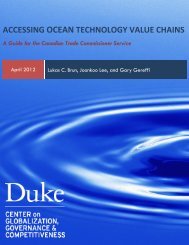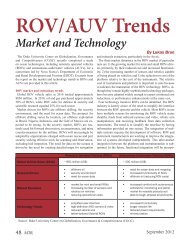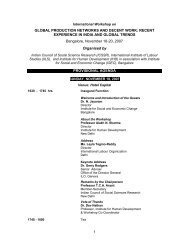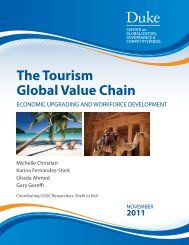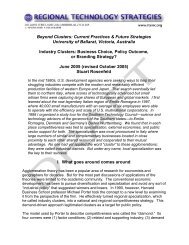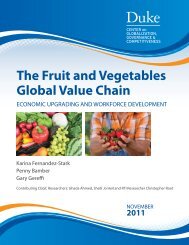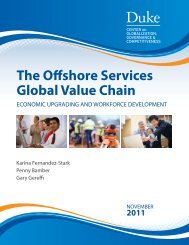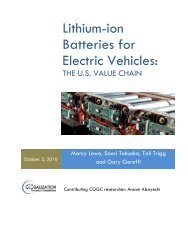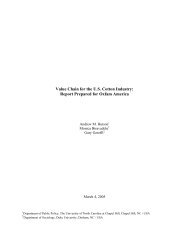Lessons from Nike
Lessons from Nike
Lessons from Nike
Create successful ePaper yourself
Turn your PDF publications into a flip-book with our unique Google optimized e-Paper software.
Improving Labor Standards<br />
in Global Supply Chains:<br />
<strong>Lessons</strong> <strong>from</strong> <strong>Nike</strong><br />
Richard M. Locke
Road Map<br />
Broader Project Goals<br />
Research Questions<br />
Data Analysis<br />
Case Studies<br />
FollowUp Research, Engagement with<br />
Stakeholders<br />
© 2007 MIT Sloan School of Management
Motivation<br />
Globalization of production has provoked fierce debate<br />
over labor standards<br />
Child labor, excessive work hours, hazardous working<br />
conditions, poor wages rampant in 3 rd world factories<br />
In absence of functioning international organizations<br />
capable of promoting global justice and/or nationstates<br />
willing or able to enforce domestic labor codes, codes of<br />
conduct and other forms of private voluntary regulation<br />
have become dominant method MNCs and NGOs address<br />
problems with labor standards<br />
Does Monitoring Work?<br />
© 2007 MIT Sloan School of Management
Million US$<br />
Why <strong>Nike</strong>?: Success Through Global<br />
Sourcing<br />
10000<br />
9000<br />
8000<br />
7000<br />
6000<br />
5000<br />
4000<br />
3000<br />
2000<br />
1000<br />
0<br />
1978<br />
1979<br />
1980<br />
1981<br />
Total Revenue Net Income 1978 2001<br />
1982<br />
1983<br />
1984<br />
1985<br />
1986<br />
1987<br />
1988<br />
1989<br />
1990<br />
1991<br />
1992<br />
1993<br />
1994<br />
Total Revenue Net Income (Million US$'s)<br />
Figure 1 Net Income<br />
Sources:<br />
a) 197897: HBS Case #9299084 "<strong>Nike</strong>, Inc.: Entering the Millennium," March 31,<br />
1999.<br />
b) 19982001: Company financial information<br />
1995<br />
1996<br />
1997<br />
1998<br />
1999<br />
2000<br />
2001<br />
© 2007 MIT Sloan School of Management
Why <strong>Nike</strong>?<br />
© 2007 MIT Sloan School of Management
Why <strong>Nike</strong>?: Suppliers Engaged in<br />
“Poor” Working Conditions<br />
© 2007 MIT Sloan School of Management
Why <strong>Nike</strong>?<br />
# of mentions<br />
180<br />
160<br />
140<br />
120<br />
100<br />
80<br />
60<br />
40<br />
20<br />
0<br />
1992<br />
1993<br />
Unfavorable media mentions<br />
Major World new spapers<br />
1994<br />
1995<br />
1996<br />
1997<br />
1998<br />
1999<br />
2000<br />
Sw eatshop Child Labor Exploitation<br />
2001<br />
2002<br />
© 2007 MIT Sloan School of Management
Why <strong>Nike</strong>?: Doonesbury<br />
© 2007 MIT Sloan School of Management
Research Questions<br />
What are working conditions actually like among<br />
<strong>Nike</strong>’s suppliers?<br />
What accounts for the variation in working conditions<br />
among <strong>Nike</strong>’s suppliers?<br />
Are working conditions improving over time in these<br />
factories?<br />
Does Monitoring Improve Working Conditions?<br />
© 2007 MIT Sloan School of Management
Research Design and Data<br />
Data Analysis of Factory Inspection Reports<br />
– (over 800 factories in 51 countries since 1998)<br />
Field Research in China, Turkey, Mexico,<br />
U.S., and Europe<br />
© 2007 MIT Sloan School of Management
Data<br />
SHAPE<br />
FLA audit<br />
Management Audit (MAudit)<br />
Compliance Rating (CR rating)<br />
© 2007 MIT Sloan School of Management
Factory Conditions Vary Across<br />
Sectors & Countries<br />
First MAudit Scores across all factories (Nov. 2002 to Jan. 2005)<br />
Density<br />
0 1 2 3<br />
Histogram:<br />
First Maudit score<br />
.2 .4 .6 .8 1<br />
Maudit score<br />
Density kdensity maudit<br />
Number of Observations: 575<br />
Average MAudit Score: 65%<br />
Similar patterns of variation within sectors (footwear, apparel,<br />
equipment) and within countries.<br />
© 2007 MIT Sloan School of Management
What Explains Variation?<br />
Factory characteristics<br />
– Factory size, ownership, type of product, etc.<br />
Interaction with the buyer<br />
– Length of relationship, percentage of capacity dedicated to<br />
<strong>Nike</strong>, frequency of visit, strategic partnership<br />
Contextual factors<br />
– Legal and regulatory environment<br />
© 2007 MIT Sloan School of Management
What Explains Variation? (Cont’d)<br />
Maudit = a0 +<br />
a1* total employees +<br />
a2* total employees^2 +<br />
a3*ownership +<br />
a4 * number of visit by <strong>Nike</strong> +<br />
a5*strategic partnership +<br />
a6* duration of relationship with <strong>Nike</strong> +<br />
a7* percentage for <strong>Nike</strong> +<br />
a8* rule of law +<br />
a9* aprl +<br />
a10*ftwr +<br />
ε (1.1)<br />
© 2007 MIT Sloan School of Management
Results<br />
© 2007 MIT Sloan School of Management
Results<br />
1) Country Effects<br />
A significant proportion of the variation is at the<br />
country level<br />
Generally, factories located in counties with higher<br />
rule of law index, proxy for strong regulatory and<br />
institutional environment, do better in compliance<br />
performance based on MAudit score<br />
© 2007 MIT Sloan School of Management
Results<br />
2) Factory Level Effects<br />
Factory size matters: generally, smaller factories are<br />
doing better in compliance<br />
Ownership does not have a significant impact on<br />
compliance performance<br />
© 2007 MIT Sloan School of Management
Results<br />
3) Relationship Between <strong>Nike</strong> and Suppliers<br />
The number of visits by <strong>Nike</strong> personnel and whether<br />
or not a factory is strategic partner are positively<br />
connected with Maudit scores.<br />
The duration of the relationship with <strong>Nike</strong> and the<br />
percentage of capacity dedicated to <strong>Nike</strong> are<br />
negatively correlated to the Maudit scores.<br />
© 2007 MIT Sloan School of Management
Are Things Getting Better?<br />
A) Change in MAudit Scores<br />
First Maudit Score<br />
Second Maudit Score<br />
Third Maudit Score<br />
Mean<br />
0.65<br />
0.70<br />
0.82<br />
Standard Deviation<br />
0.16<br />
0.16<br />
0.07<br />
© 2007 MIT Sloan School of Management
Are Things Getting Better?<br />
Test1 <strong>Nike</strong> randomly chose which firms to<br />
do the second Maudit.<br />
Factories with only<br />
one Maudit<br />
Factories with more<br />
than one Maudit<br />
Mean<br />
0.65<br />
0.64<br />
First Maudit Score<br />
Standard Deviation<br />
0.16<br />
0.16<br />
458<br />
117<br />
Test2 Second Maudit scores are on<br />
average better than first scores.<br />
# of observations<br />
© 2007 MIT Sloan School of Management
Are Things Getting Better?<br />
Maudit(i,t) = a0 +<br />
a1*num_employee(i,t) +<br />
a2*num_employee(i,t)^2 +<br />
a3*ownership(i, t) +<br />
a4 * shape_visit(i,t) +<br />
a5*strategic(i,t) +<br />
a6*month_<strong>Nike</strong>(i,t) +<br />
a7*<strong>Nike</strong>_percentage(i,t) +<br />
a8*rule of law(i,t) +<br />
a9* aprl(i,t) +<br />
a10*ftwr(i,t) +<br />
b*effort(i,t) +<br />
ε(i,t)<br />
© 2007 MIT Sloan School of Management
Are things getting better: CR rating<br />
60<br />
50<br />
40<br />
30<br />
20<br />
10<br />
0<br />
01<br />
02<br />
02<br />
03<br />
03<br />
04<br />
04<br />
05<br />
A<br />
B<br />
C<br />
D<br />
© 2007 MIT Sloan School of Management
Are Things Getting Better?<br />
B) Change in Compliance Rating Inspections<br />
Change in CR Rating<br />
3 (Down by 3 degrees)<br />
2 (Down by 2 degrees)<br />
1 (Down by 1 degree)<br />
0 (No change)<br />
1 (Up by 1 degree)<br />
2 (Up by 2 degrees)<br />
3 (Up by 3 degrees)<br />
Total<br />
Freq.<br />
323<br />
116<br />
763<br />
0.92<br />
100<br />
Note: A is 4, B is 3, C is 2, and D is 1, and the change in CR rating is the score in the most recent<br />
audit minus the score <strong>from</strong> the earliest audit, ranging <strong>from</strong> –3 to 3. For example, if a factory has a<br />
score C in the earliest audit and a score A in the most recent audit, then it has a change of +2.<br />
20<br />
74<br />
181<br />
42<br />
7<br />
Percent<br />
2.62<br />
9.70<br />
23.72<br />
42.33<br />
15.20<br />
5.50<br />
© 2007 MIT Sloan School of Management
Are things getting better?<br />
How do we interpret apparently contradictory findings<br />
between MAudit and CR rating analyses?<br />
– MAudit privileges documentary evidence, whereas CRrating is<br />
more subjective.<br />
– Suppliers are “learning” to go through the MAudit, whereas <strong>Nike</strong><br />
compliance staff are not fooled.<br />
– Audits based on different samples of firms.<br />
© 2007 MIT Sloan School of Management
Qualitative Analysis<br />
– A Tale of 2 Factories<br />
Average Weekly Wage<br />
Team Work<br />
Job Description<br />
Job Rotation<br />
Worker Participation in<br />
WorkRelated Decisions<br />
Nationality<br />
Overtime<br />
Workplace Characteristics<br />
Managers<br />
Supervisors<br />
Production Workers<br />
Plant A<br />
$ 86.00 USD<br />
Yes<br />
MultiTasks<br />
Yes<br />
Yes<br />
Mexican<br />
Mexican<br />
Mexican<br />
Voluntary and<br />
Within Limit<br />
Plant B<br />
$ 67.80 USD<br />
No<br />
Single Task<br />
No<br />
No<br />
Chinese<br />
Chinese<br />
Mostly Mexican<br />
Mandatory and<br />
Over Limit<br />
© 2007 MIT Sloan School of Management
Qualitative Analysis<br />
– A Tale of 2 Factories continued<br />
Comparison of Production Systems<br />
Total # of Workers<br />
in one line or cell<br />
TShirts per Day<br />
per line or cell<br />
Daily Wage per Worker<br />
(Fixed Salary + Bonuses)<br />
TShirts per Worker<br />
Cost per TShirt<br />
Plant A<br />
6<br />
900<br />
$ 17.20 USD<br />
150<br />
$ 0.11 USD<br />
Plant B<br />
10<br />
800<br />
$ 13.60 USD<br />
80<br />
$ 0.18 USD<br />
© 2007 MIT Sloan School of Management
Qualitative Analysis<br />
– A Tale of 2 Factories continued<br />
Comparison between Old and New<br />
System of Production in Plant A<br />
Total # of Workers<br />
TShirts per Day<br />
per module or cell<br />
Productivity per Worker<br />
Average Weekly Salary<br />
Old System<br />
(module)<br />
10<br />
1200<br />
120<br />
$ 67.80 USD<br />
New System<br />
(cell)<br />
6<br />
900<br />
150<br />
$ 86.00 USD<br />
© 2007 MIT Sloan School of Management
OnGoing Research/Outreach<br />
Outreach<br />
Other <strong>Nike</strong> Research:<br />
• UpStream Business Processes<br />
• CR/Business Outcomes<br />
• NOS Effect<br />
Research on Other Companies<br />
(PVH, Coke)<br />
Stakeholder Engagement<br />
(FLA, WRC, Joint Initiative, World Bank, ILO)<br />
© 2007 MIT Sloan School of Management
Doonesbury Again<br />
© 2007 MIT Sloan School of Management



